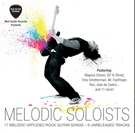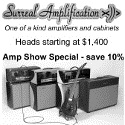Here’s what’s wrong with YOUR sweep picking technique…
 If you began to read this article, chances are that you have been working on your sweep picking technique and struggled with improving it. If this sounds like you, then I want to show you how to avoid the 4 most common technical pitfalls that many guitarists fall into when trying to improve their sweep picking.
If you began to read this article, chances are that you have been working on your sweep picking technique and struggled with improving it. If this sounds like you, then I want to show you how to avoid the 4 most common technical pitfalls that many guitarists fall into when trying to improve their sweep picking.
These four problem areas typically do not occur in isolation. Typically if you have one of the four problems described below, you have the others to some degree also. The good news though is that once you work on fixing at least one of these problems, the others tend to improve as well (it works both ways). As you read on, you will understand why.
If you want me to show you on video how to correctly practice the following ideas in this article, you can watch a (totally free) 20 minute sweep picking video lesson at my website that is available to my free newsletter subscribers. Otherwise, I will do my best to explain these technical points to you using text alone.
Separating the notes
Many players struggle with separating the notes of arpeggios, because they do not release the fingers from the notes that have already played, which results in all of the notes of the arpeggio ringing together. Although this follows the theory of “minimum motion” for the fingers, it breaks the most important rule of clean sweep picking: each note must have definition and clarity! So on one hand, it is tempting to want to minimize the motion of the fretting hand fingers as much as possible, and on the other hand, you also need to make sure that the notes are sounding cleanly.
The solution is to find the balance between releasing the fingers from each note right after you have played it, but doing so without letting the fingers come up “too far” away from the strings. Obviously if your fingers move too far away from the strings, it makes it difficult to bring them back down to play when needed. That being said, you need to lift the finger off the string slightly after it has played (so that it stops ringing), and also mute that same string with your picking hand (more about this later).
Remember that economy of motion is a “relative” concept and not an “absolute” concept. So even though releasing the fingers from the notes they have played is not an “absolute” application economy of motion, it is necessary to do this in order to play the technique cleanly. This advice may seem like perfect common sense when you read about it, but MANY guitarists have a difficult time with finding the right balance between the economy of motion and playing cleanly (in this part of guitar playing technique especially, but also with other techniques).
Rolling
One of the biggest sources of confusion of the rolling technique is that it is often confused with “barring”. When you play barre chords, you fret notes of two or more strings at the same fret with the same finger and you let all the notes ring together. When you perform the rolling technique, you have to actually physically “roll” the finger across strings by bending it backwards. As a result, the notes sound separated.
This technique is best shown on video or in person, but basically you play the first note of the roll with the tip of the finger, and then bend it backwards fretting the remaining notes of the roll with the soft fingerprint. You then reverse the motion when you descend. Your first knuckle of the finger becomes the pivot point that bends or collapses allowing you the flexibility of fretting the notes cleanly. If you are unsure about how to specifically practice this motion, I can show you precisely what the finger rolling motion should look like in the free sweep picking video at my site.
The good news about the rolling technique is that although it is hard in the beginning, it is actually one of the absolute easiest things to do on guitar once you get better at it. But in order to make sure that you do master it in minimum time, make sure to follow the guidelines above.
Pull offs:
Many players neglect isolating and practicing this part of the arpeggio in the shapes that require a pull off on the top string. As a result, the weak pull off distorts the rhythm of the notes and the arpeggio doesn’t sound clean. The picked notes usually sound rushed, and come out much louder than the pull off (which is barely audible). The solution is to practice just the pull off part of the arpeggio with the amp off. You should be able to hear the pull off very clearly even with the amp turned off. If you apply more force to make the pull off loud when you practice with no distortion, then after you turn distortion on, it really becomes a lot easier to play the entire arpeggio smoothly and cleanly.
Try to match the volume of your pull offs as closely as possible to that of your picked notes. This will not be entirely possible, but by constantly striving for it you will make great improvements in your legato playing in general and in this area of sweep picking specifically.
Muting excess string noise
The conventional wisdom suggests to practice sweep picking with a clean guitar tone in order to make it easier to hear imperfections in your technique. This is true on some level, BUT practicing only with a clean tone makes it hard to hear excess string noise that can occur either from letting the notes ring together (problem 1 described above) or from not muting the strings that are not supposed to be playing.
In reality, it is even more important to practice with distortion because only then will you become aware of any excess noise that may be present and correct it. If you have limited time to practice, then definitely you should practice with distortion only. This one practicing tip (which I learned from my guitar teacher, friend and mentor Tom Hess) helped me to greatly improve my own sweep picking in a short amount of time.
When you do become aware of the sloppy extra noise, it becomes much easier to fix it and mute it (using a variety of techniques in your picking and fretting hands).
Think carefully about the points in this article and apply them to your playing. You will see great results when you do!
If you are unclear about any part of what I explained above and want to see me do it on video, visit my website and I will show you the free sweep picking lesson on video that I send to all my newsletter subscribers. You can also contact me by e-mail at mike@mikephilippov.com with any questions.
About Mike Philippov:
Mike Philippov is a professional virtuoso guitarist, music composer and instructor. He is also a co-author of several instructional products, numerous articles and other free instructional resources available on http://mikephilippov.com
Visit Mike’s sites:
©2009 Mike Philippov All Rights Reserved
Used by Permission










